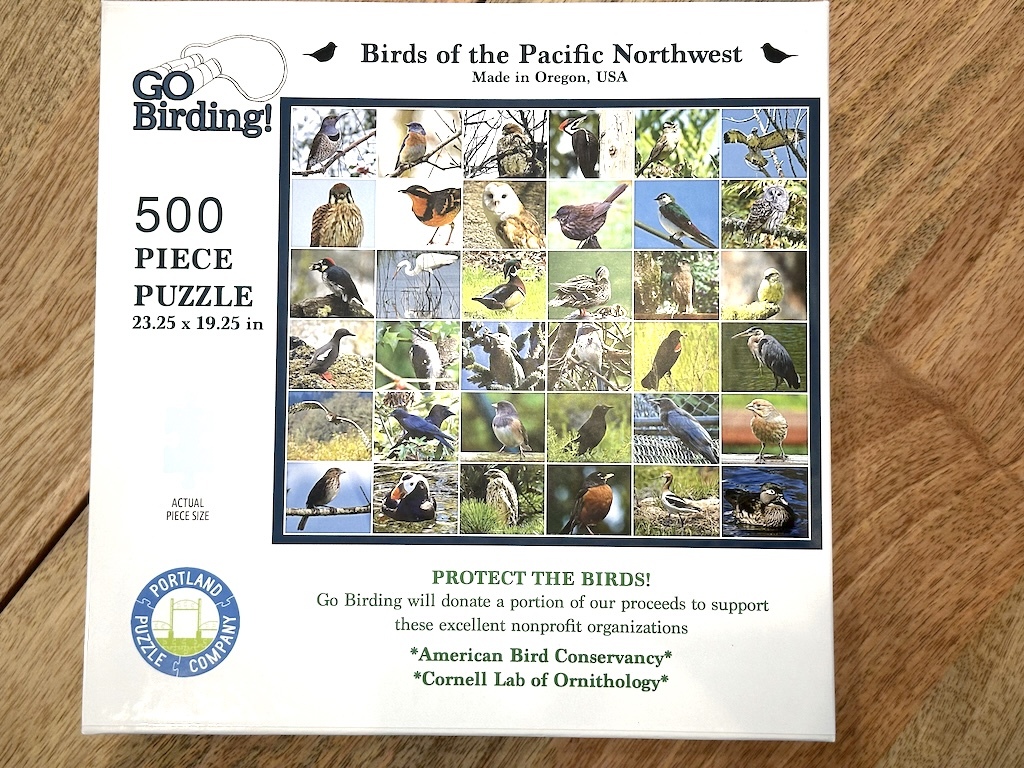
Welcome to Go Birding, the card game designed to captivate the hearts of both bird enthusiasts and game lovers alike!
Go Birding combines the joy of bird-watching with the engaging gameplay of a card game.
Whether you're an avid birder or simply enjoy a good game night, this is the perfect game to spread your wings and soar into a world of feathered delight.
🦉
Meet The Birds
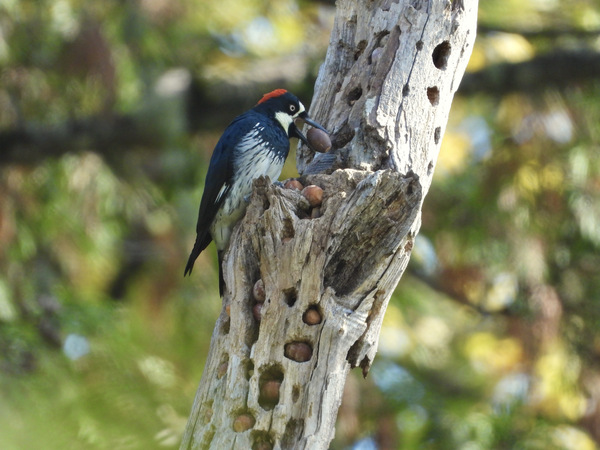
Acorn Woodpecker
Melanerpes formicivorusAcorn Woodpeckers have a black body with white belly and rump, and unique face pattern of black, white, and red. Females have a red cap at the top of their head with a black area between the forehead and the cap while the males have a red cap starting at the forehead.
They inhabit oak woodlands and pine-oak forests in the western United States, Mexico, and parts of Central America.
They are non-migratory and tend to stay in the same areas year-round.
Their call is a unique, rattling 'waka-waka-waka' sound.
Acorn woodpeckers are known for their habit of storing acorns in individually drilled holes in a granary tree.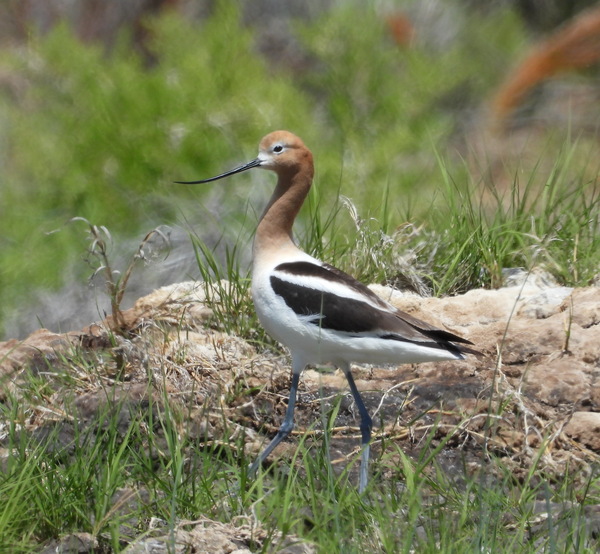
American Avocet
Recurvirostra americanaLarge shorebird with a unique, upturned bill. They have a black and white body with a rusty head that turns grayish white in winter.
Wetlands of interior and western North America.
Migrates to the southern and coastal United States and Mexico for winter.
A repeated, sharp, accented 'kleek' in flight.
The American Avocet will sweep its bill from side to side underwater to catch aquatic invertebrates.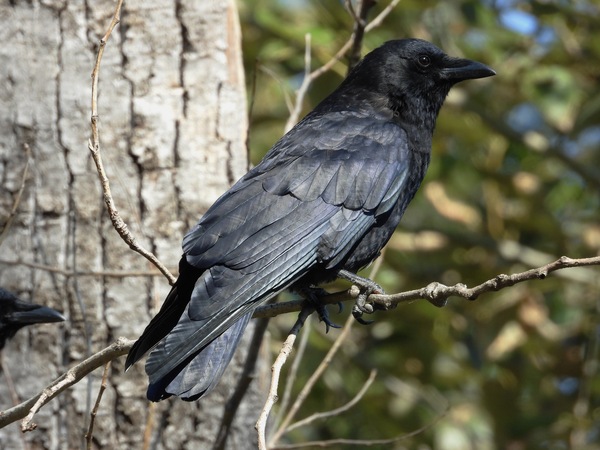
American Crow
Corvus brachyrhynchosCompletely black bird including feathers, eyes, and beak. Crows are large, intelligent birds with a straight, moderately long tail.
Found in a variety of habitats across North America including forests, fields, parks, and urban areas.
Generally non-migratory with short-distance northern populations occasionally moving south.
Known for its cawing sound, which is loud, bold, and commonly heard in groups.
They are highly intelligent problem solvers, very social among their flock, and can even learn to recognize human faces.
American Robin
Turdus migratoriusLarge songbird with a bright red-orange belly, grayish brown upper body, dark head, and a yellow bill.
Wide range of habitats including woodlands, gardens, and city parks across North America.
Northern populations migrate to the southern U.S. or Mexico for winter.
A series of rich, whistled phrases often described as 'cheerily, cheer up, cheer up, cheerily, cheer up'.
Robins have a characteristic movement where they quickly sprint while stooped to the ground then suddenly stop to stretch their neck and look around before heading off again.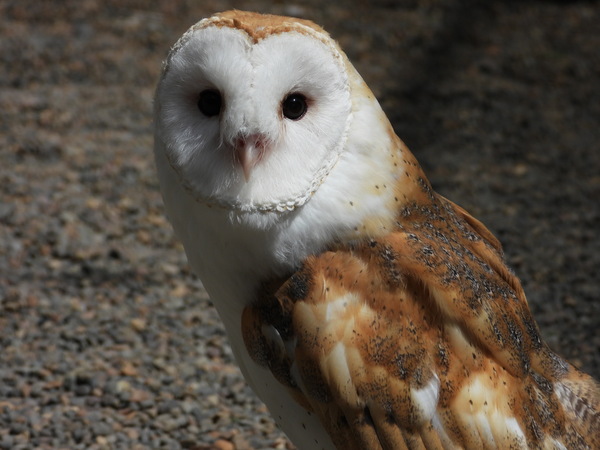
Barn Owl
Tyto albaMedium-sized owl with a heart-shaped, white face and dark eyes. The upper body is light gray with a speckled pattern and white underneath.
Found in the open country, such as farmland and woodlands worldwide.
Generally non-migratory.
A shrill, eerie 'scree-scree,' or a long, harsh scream that lasts about 2 seconds.
These owls have an impressive ability to catch prey in complete darkness by sound alone.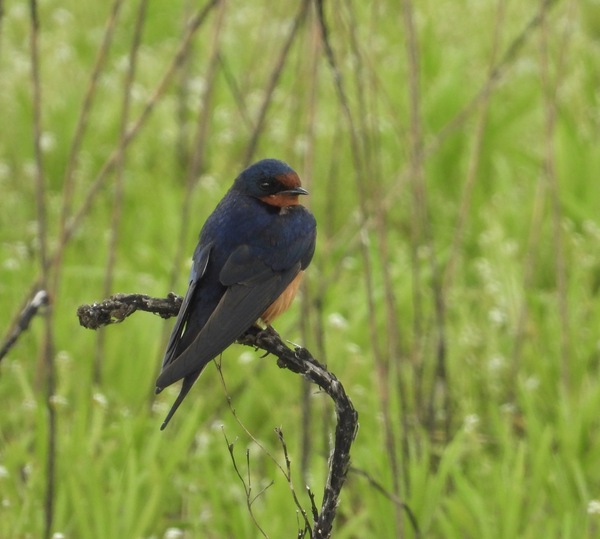
Barn Swallow
Hirundo rusticaMedium-sized songbird with a deep blue upper body, a reddish orange forehead, chin and throat, and a pale underbody. They have a long, deeply forked tail.
Found near open areas, farms, fields, marshes, and over water bodies across North America.
They migrate to Central and South America during winter.
A series of soft, gurgling whistles and twitters.
Barn Swallows are excellent flyers and spend most of their day in the air foraging for insects.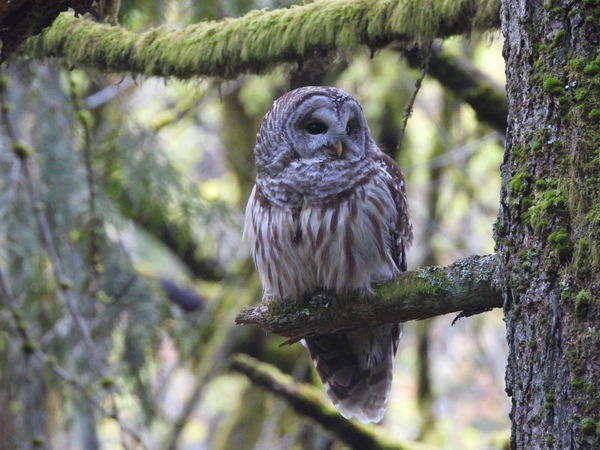
Barred Owl
Strix variaMedium to large-sized owl with a distinctive 'barred' white and brown plumage on their belly. They have dark eyes and a yellow beak.
Prefer wooded areas with mature trees near water in eastern and central North America.
Generally non-migratory.
Their hoo-hoo call is instantly recognizable, often phrased as "who cooks for you."
Sometimes they will eat enough shellfish to turn their feathers under their wings a soft shade of pink.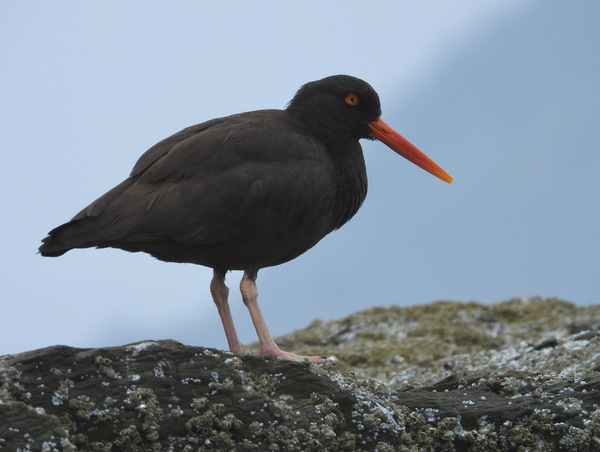
Black Oystercatcher
Haematopus bachmaniEntirely black with a yellow eye and a long, bright reddish-orange bill.
Rocky shorelines of the Pacific Ocean.
Generally non-migratory.
A series of whistles and piping sounds.
Despite their name, the Black Oystercatcher's diet consists mostly of mussels and limpets rather than oysters.
Black-crowned Night Heron
Nycticorax nycticoraxThese herons are around 25 inches in length. They sport a stocky figure with a black crown and back, pale gray belly, and red eyes. Young birds are brown and spotted. In both sexes, the legs turn a vibrant pink in the breeding season.
They are found in wetland habitats across North America.
Black-crowned Night Herons in the northern parts of their range migrate south for the winter.
They can make squawks, screams, clucks, and also guttural sounds.
Unlike other heron species, they are most active at night when they will forage for food in the dark.
Brewer's Blackbird
Euphagus cyanocephalusFemales have dark brown eyes with grayish brown feathers while the males have yellow eyes and a darker black body. Both sexes have iridescent purple, green, and blue highlights visible in the right lighting.
Typically found in open and semi-open habitats in the western and central North America, often near humans.
Some populations in Canada and the northern U.S. migrate south for winter.
A series of short, high, thin, sweet sounds, and also a drawn out 'squeee' sound, often in flight.
Beneficial to farms by eating insect pests and preventing outbreaks from destroying crops.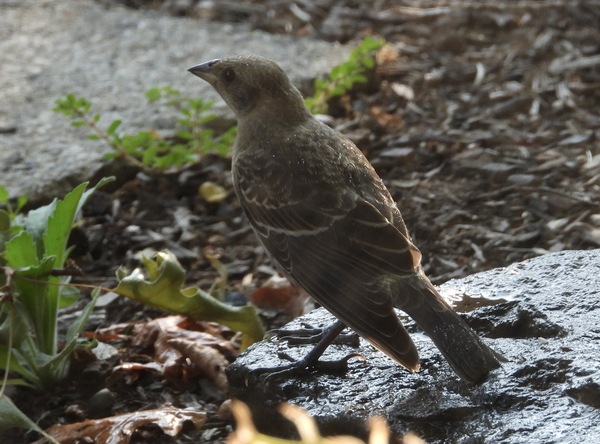
Brown-headed Cowbird
Molothrus aterFemales are brownish-gray while males are shiny black with a brown head.
Can be found across North America in fields, pastures, meadows, and residential areas.
Northern populations travel to the southern U.S. for winter.
The song is a bubbly liquid-like chatter with sliding whistles, often sung from a high perch.
Cowbirds practice brood parasitism - females lay their eggs in the nests of a variety of other bird species, letting them raise their young. At 3-4 weeks of age, the juveniles begin to flock with other cowbirds.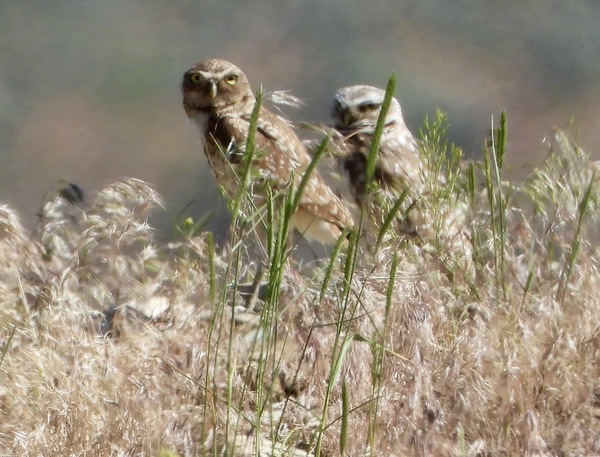
Burrowing Owl
Athene cuniculariaSmall, long-legged owl with bright yellow eyes and white eyebrows. They have a speckled, brown upper body and a lightly barred underbody.
Found in grasslands, rangelands, agricultural areas, and desert habitats in North and South America.
Some populations are migratory, often moving southwards in winter.
A variety of calls including a "who who" sound and a chuckling chatter.
Unlike other owls, they are active during the day and are named for their habit of nesting in burrows in the ground.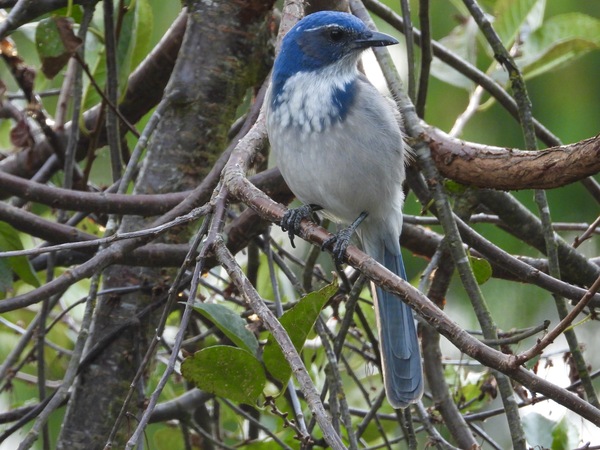
California Scrub-Jay
Aphelocoma californicaBlue and gray with a well-defined blue breast band, a whitish throat, and a long tail.
Woodlands, scrublands, and backyards along the western coast of the U.S.
Non-migratory
A harsh, scratchy 'shreeeeek.'
Known for their intelligence and complex social systems and are one of only a few species of bird that can recognize their own reflection in a mirror.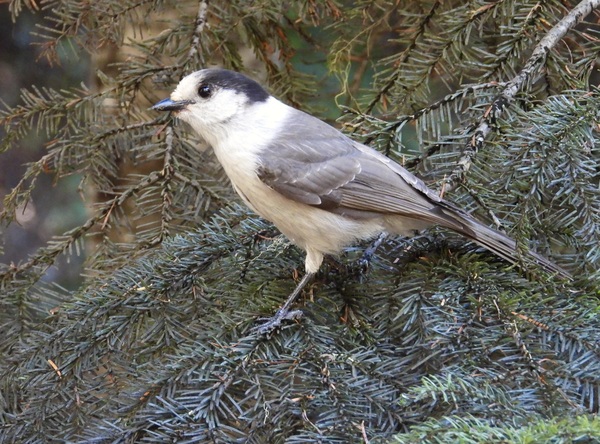
Canada Jay
Perisoreus canadensisA medium-sized bird with a rounded head, short bill, and long tail. Upperpart is gray, underneath they are lighter, and the head is whitish with a dark 'cap' and 'necklace.'
They live in higher elevation coniferous forests in the northern latitudes of North America.
Non-migratory
A variety of soft whistles, clicks, and pleasant chatters.
Canada jays store large quantities of food for the winter by caching it in trees and covering it with sticky saliva.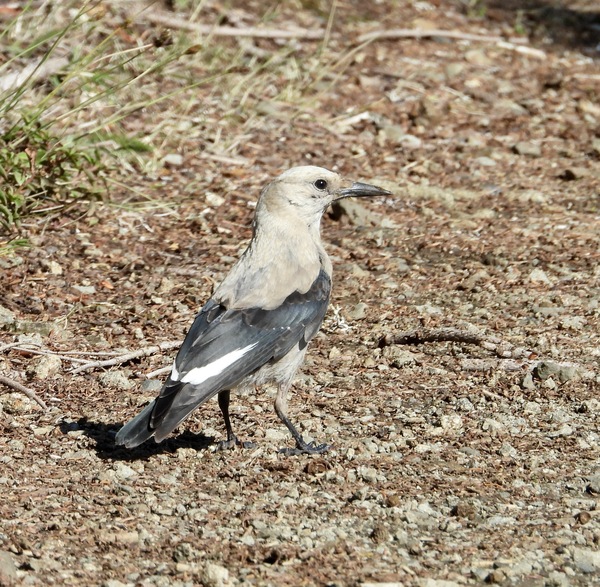
Clark's Nutcracker
Nucifraga columbianaMostly gray birds with black wings and central tail feathers and white on the edges of the tail and wing feathers.
High mountain regions of the west, extending into the Pacific Northwest and Canada.
Non-migratory but may move to lower elevations during winter.
A loud, penetrating, harsh, and raspy call.
Clark's Nutcracker can remember the locations of thousands of stored seeds and nuts to retrieve them later, even months after hiding them.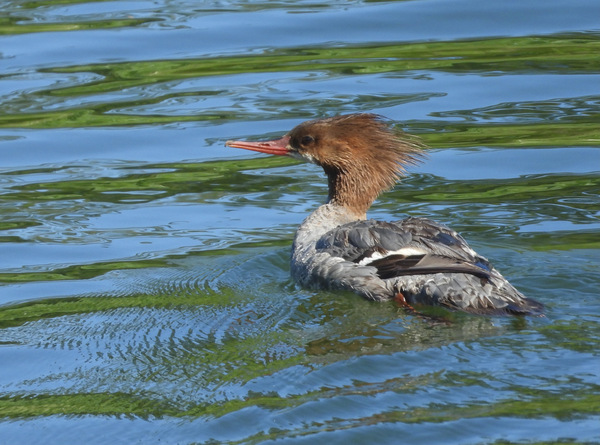
Common Merganser
Mergus merganserLarge duck with a thin, serrated, orange bill. Females have a gray body with rusty head while males have a white body, black back, and greenish head.
Found in freshwater lakes and rivers across the northern United States and Canada.
Birds in the coldest regions migrate south for winter.
Generally silent, but sometimes make low raspy croaks.
Common Mergansers are skilled fishers - they catch fish by diving underwater and seizing them with their bills.
Common Murre
Uria aalgeMedium-sized bird with black or dark brown upper body and white underbody. They have a thin, pointed bill and during breeding season, they have a small pointed crest at the rear of the head.
Found on the open sea, rocky shores, and islands in the northern Atlantic and Pacific Oceans.
Migratory to the open ocean, but not far from breeding colonies.
A growling 'haa-haa-haa'.
Common Murres nest in large colonies on cliff edges and can dive up to 600 feet deep in search of food.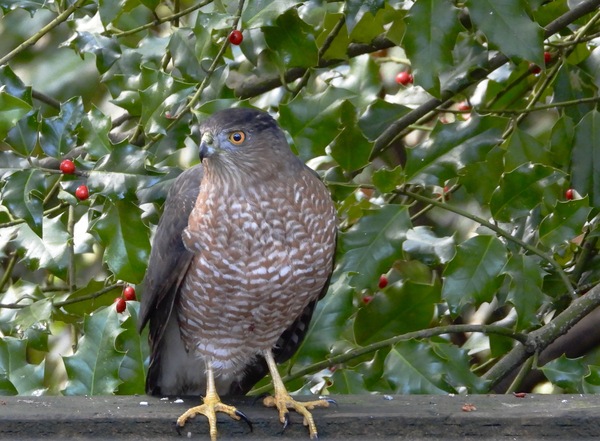
Cooper's Hawk
Accipiter cooperiiMedium-sized hawk with broad, rounded wings and a long tail. Juveniles are more brown and streaky while adults have gray backs with reddish chest, black cap, and red eyes. Their tail has alternating dark brown and gray bands with white terminal.
Wooded habitats from deep forests to leafy subdivisions and backyards across North America.
Northern populations migrate south for the winter.
A loud, repeated 'cak-cak-cak.'
Cooper's Hawks are skilled bird hunters that hunt birds mid-air and can fly swiftly through dense forests.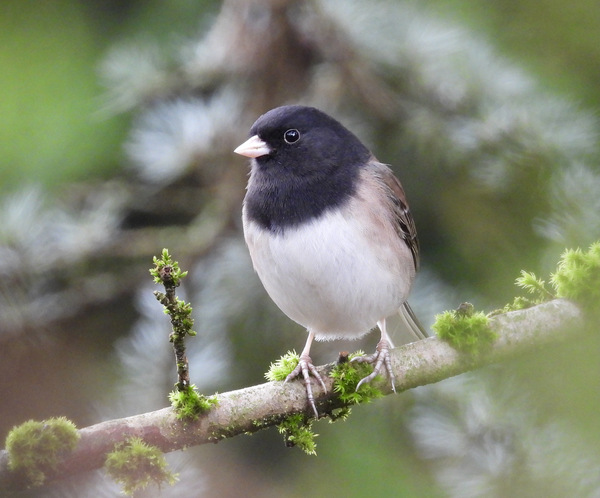
Dark-eyed Junco
Junco hyemalisMedium-sized sparrow characterized by its dark head, white belly, and white outer tail feathers. Shades can vary based on region.
Forest edges and areas with dense shrubs or small trees throughout Canada, the United States, and Mexico.
Northern populations migrate south for winter, while those in the western U.S. move to lower elevations.
They can make chips, whistles, or trill sounds.
They often have two broods in a single breeding season. If a second brood is to occur, the male continues attending to the first brood while the female moves on to lay and incubate the next set of eggs.
Double-crested Cormorant
Phalacrocorax auritusA large waterbird with black body and yellow-orange throat pouch. Notable features include their thin hooked bill and two small tufts at the back of the head, visible in breeding season.
Coasts, inland waterways, and lakes across North America.
Birds in the northern range migrate south to the coast in winter.
Low, guttural grunts.
Their feathers aren't fully waterproof which helps them dive and swim with ease. You'll often see them standing with their wings outstretched to dry.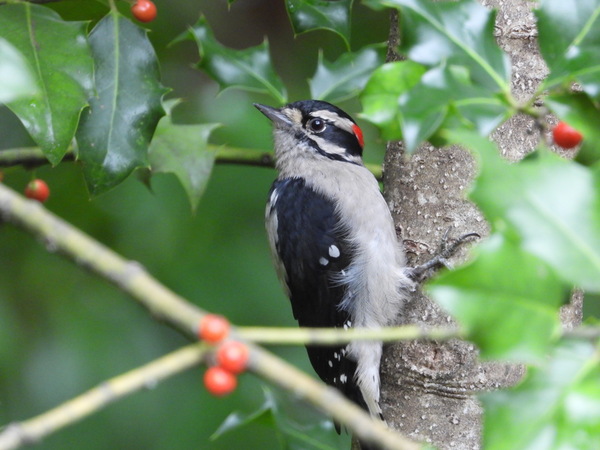
Downy Woodpecker
Picoides pubescensDowny Woodpeckers are the smallest woodpecker species in North America. They have a black upper body, white underparts, and white spots on their wings. Their tails are black with white outer feathers. Males have an added red patch on the back of their heads.
They are found in deciduous and mixed forests, orchards, and fields across North America.
Downy Woodpeckers are generally non-migratory.
They have a soft 'pik' sound and their drumming is slow compared to other woodpecker species.
They can forage on twigs and plant stems, and even on weed stalks, which many larger woodpeckers can't do.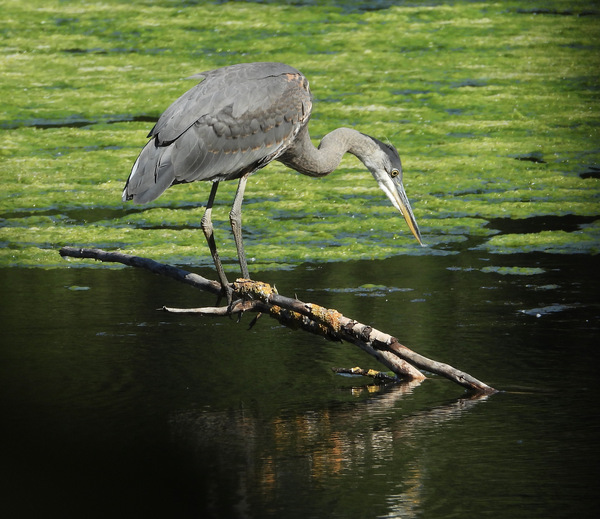
Great Blue Heron
Ardea herodiasGreat Blue Herons are large birds with a blue-gray body, long neck, and long, pointed bill.
They are found along coasts, in marshes, ponds, rivers, and lakes in North and Central America.
Most Great Blue Herons migrate south for the winter, but some birds in the southern U.S. and areas with mild winter climates are permanent residents.
Their call is a deep and harsh croak and can also clap their bill tips together.
Their neck is lightning quick in capturing its prey, stretching to 3x its resting length to grab nearly any smaller animal within striking distance.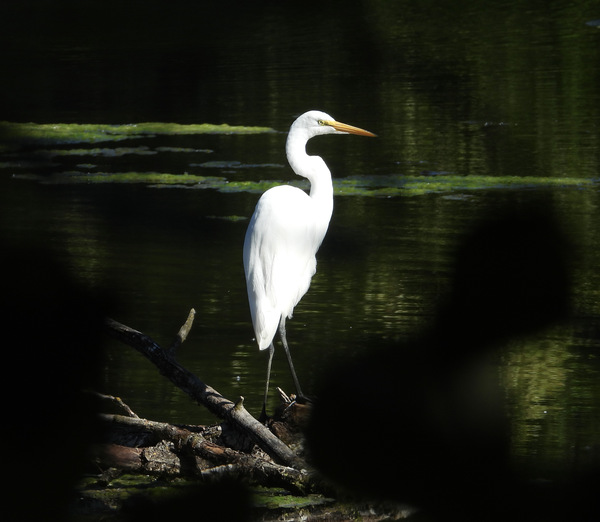
Great Egret
Ardea albaTall and long-necked birds with all-white plumage, a yellow bill, and black legs. During the breeding season, they develop long, elegant plumes on their backs.
They are found in wetlands, ponds, and shores across all continents except Antarctica.
In North America, Great Egrets migrate south for the winter.
Their call is a low, soft croak. They will also snap together their beak to make a clacking sound.
Great Egrets were once hunted nearly to extinction for their plumes, leading to some of the first laws to protect birds.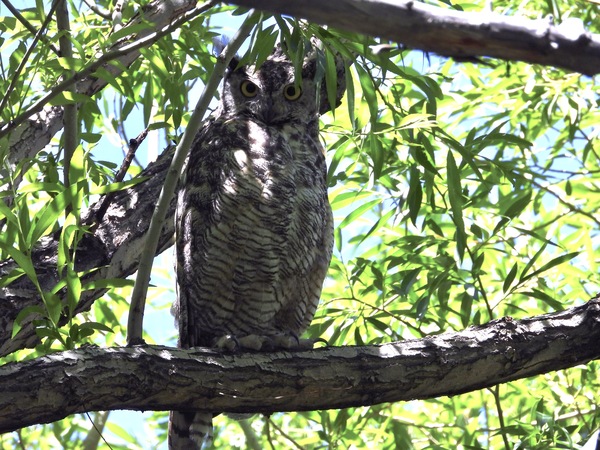
Great Horned Owl
Bubo virginianusLarge owl with recognizable ear tufts, yellow eyes, and a white bib. Their feathers are brown with shades ranging from grayish to cinnamon depending on region.
Found across North America in forests and swamps.
Generally non-migratory.
A deep soft "hoo-hoo hoo-hoo."
Great Horned Owls are one of the most common owls in North America and are known for their ability to adapt to different habitats. This species was the basis for Miyazaki's Totoro character!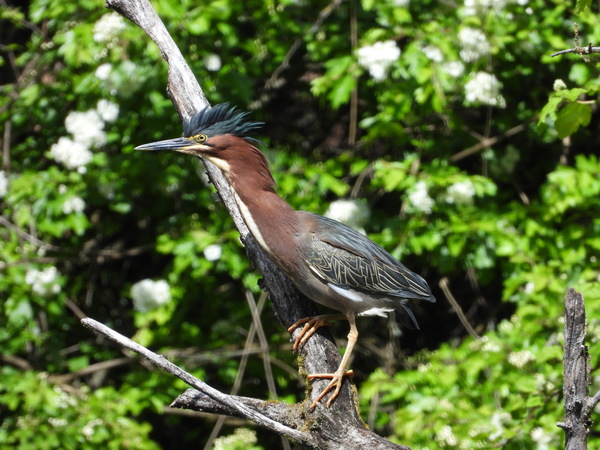
Green Heron
Butorides virescensSmall herons with a dark green back, rich chestnut body, and a dark cap often raised into a short crest.
They are found in wetland habitats across North and Central America.
Green Herons from the northern part of their range migrate to Central America for the winter.
Their call is a loud and sudden 'skeow' sound.
The Green Heron is one of the few bird species that uses tools. It commonly drops bait onto the surface of the water and grabs the small fish that are attracted.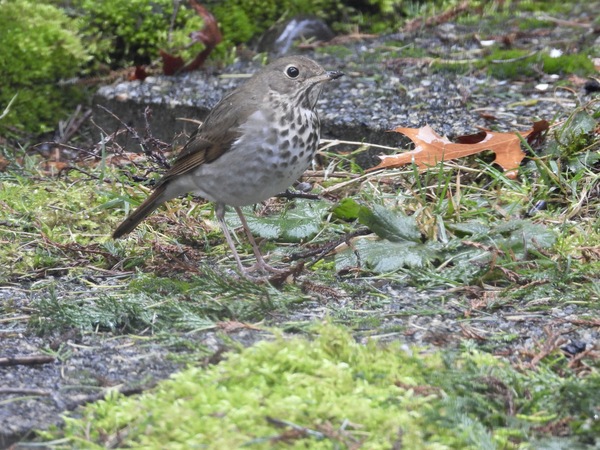
Hermit Thrush
Catharus guttatusSmall brown thrush with a pale spotted underbody and faintly reddish tail and rump.
Forests and woodlands across North America.
They migrate to central and southern United States, Mexico, and Central America for winter.
A lovely, flute-like song, starting with a single note and followed by a trill.
Hermit thrush change their diet according to the season. In winter they mostly eat fruit such as berries while in spring they go for insects and the occasional small amphibian.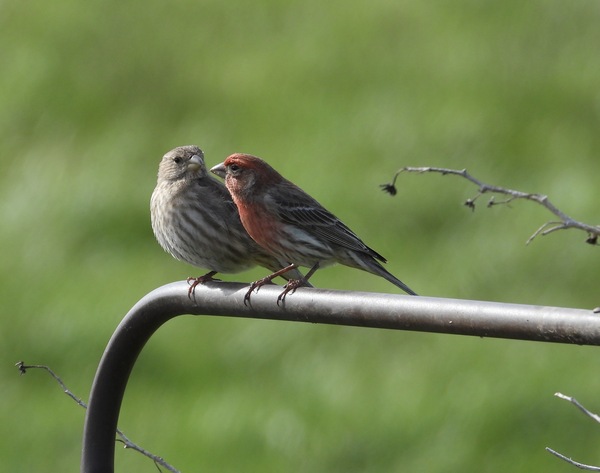
House Finch
Haemorhous mexicanusSmall-bodied finches. Females are grayish-brown with thick, blurry streaks. Males are streaked brown with a bright red face, upper back, and rump.
Urban and suburban areas across North America.
Generally non-migratory.
A rapid, cheery warble or a variety of chirps.
The color of the male's breast varies in intensity with the seasons and is derived from the berries and fruits in its diet.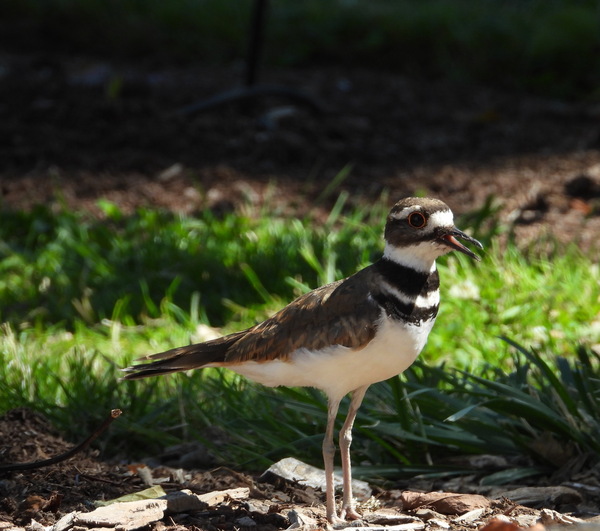
Killdeer
Charadrius vociferusMedium-sized plover with two black bands on the chest, a brown upper body, and white underbody. They have a red eye-ring.
Open, disturbed habitats like fields, lawns, parking lots across North America.
Northern populations migrate to the southern United States and Central America.
A loud, shrill "kill-dee" or "kill-deer".
Killdeer are known for their dramatic 'broken-wing' display which they perform to lure predators away from the nest.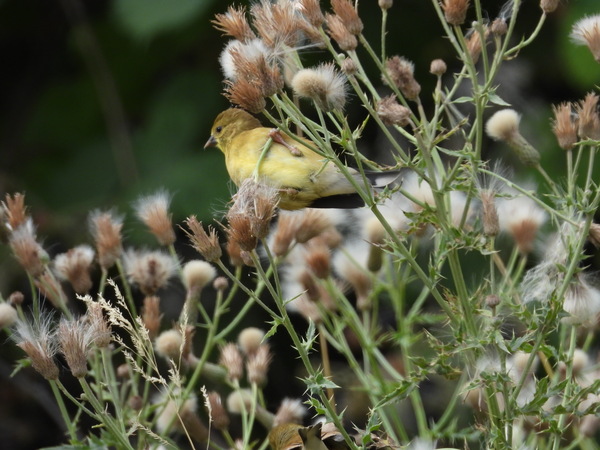
Lesser Goldfinch
Spinus psaltriaSmall finches. Females are olive brown and yellow while males are brighter yellow. Both sexes have black on their wings and tail. In the males of the eastern population, the back is black.
Found in open woods, scrub, gardens, and parks in the western and southern states of the U.S.
Non-migratory, but may move locally due to food availability.
Their songs are a series of musical warbles and trills.
Lesser Goldfinches often hang upside-down to feed.
Mallard
Anas platyrhynchosFemales are mottled brown with brown orange bill while males have a gray body with green head and bright yellow bill. Both sexes have a wing patch that is violet-blue bordered by white.
Varied habitats from parks to wetlands to small ponds across North America.
Generally, non-migratory, but birds in the coldest regions migrate south for winter.
Females make the well known distinctive 'quack' call while the male do not quack at all but make one or two note raspy sounds.
The mallard is the ancestor of nearly all domesticated duck breeds.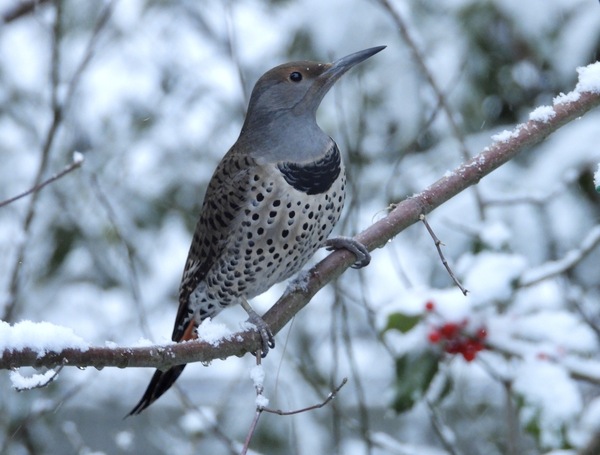
Northern Flicker
Colaptes auratusNorthern Flickers are large woodpeckers with brown body with black bars and spots, a black bib, and a white rump. The underwings and undertail are bright yellow or red, depending on the subspecies. Males have an additional black or red mustache stripe.
They are found in forests, woodlands, and suburban areas across North America.
Some Northern Flickers migrate, moving southwards in the fall.
Their call is a loud "flick-a-fliick-a" sound.
Unlike many woodpecker species, Northern Flickers often forage on the ground, mostly eating ants and beetles. They can be found pecking at the earth, much like thrushes.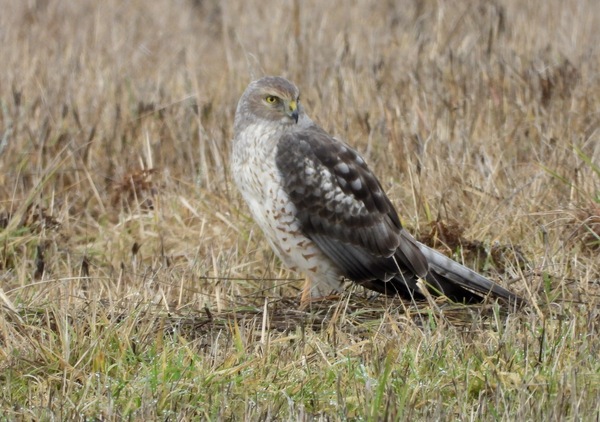
Northern Harrier
Circus hudsoniusMedium-sized hawks with distinctive owl-like face, long, narrow tails and a white rump. They have sleek, slender bodies and rounded wings. Females are streaked brown while males are more gray.
Open marshes and grasslands across North America.
Partially migratory, with birds in Canada and northern USA moving south for the winter.
A whistled 'kek-kek-kek' call.
Unlike most hawks, Northern Harriers rely on both vision and hearing to capture prey, thanks to their owl-like facial disk.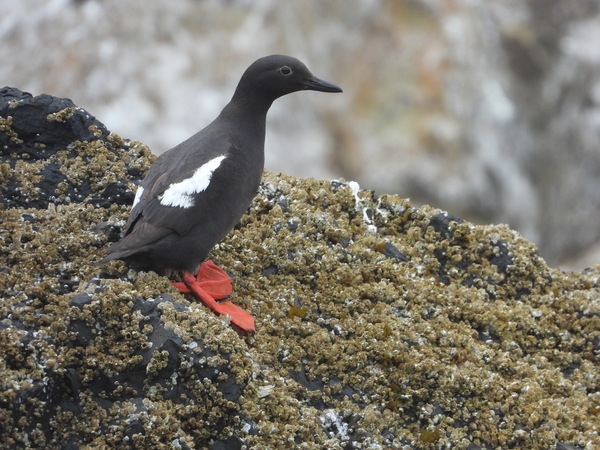
Pigeon Guillemot
Cepphus columbaMedium-sized bird with black body and bright red feet. They have a thin dark bill, and white wing patches which are prominent in flight.
Can be found along the rocky coastlines of the north Pacific.
Non-migratory, but move offshore during winter.
A high, whistling 'wheep-wheep'.
Pigeon Guillemots are known to dive up to 150 feet deep to hunt for food. Males court by circling and showing off their bright red feet.
Pileated Woodpecker
Dryocopus pileatusPileated Woodpeckers are the largest common woodpecker in the U.S. They are mostly black with white stripes on the face and neck and a flaming-red crest. Males have an additional red stripe on their cheeks.
They are found in mature forests across Canada, the eastern U.S., and parts of the Pacific Coast.
Pileated Woodpeckers are non-migratory, tending to stay in the same home range year-round.
Their call is a distinct, loud, far-carrying laugh 'kuk-kuk-kuk-kuk-kuk'.
Pileated Woodpeckers drill rectangular-shaped holes in trees to find ants. These excavations can be so broad and deep that they can cause small trees to break in half.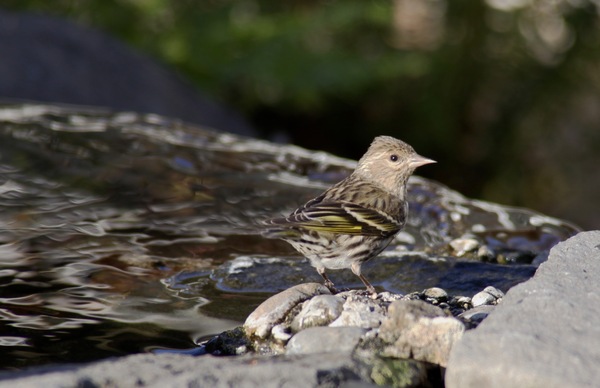
Pine Siskin
Spinus pinusSmall finches with sharp, pointed bills and short, notched tails. Their coloration is brown and streaky overall, with yellow edging on the wings and tails.
Coniferous and mixed forests across Canada, the western U.S., and the Appalachian Mountains.
Irregular migrant, with winter irruptions further south during periods of food shortage within their normal range.
A sharp, rising 'zzzzreeeee' and various twitters and chips.
Pine Siskins travel in large numbers and are resistant to very cold temperatures.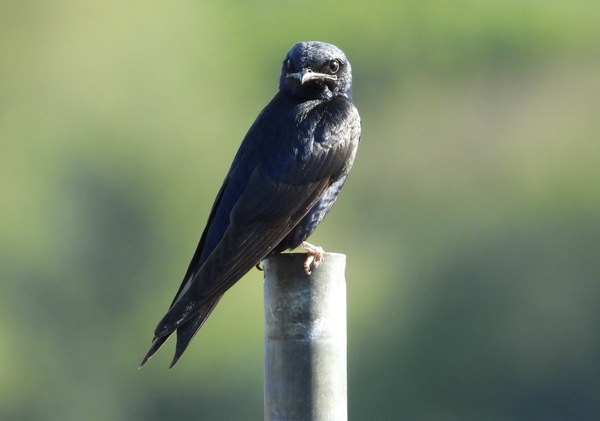
Purple Martin
Progne subisLarge swallow with an iridescent dark purple body and forked tail. Females have more purple on their head and lighter on their chest, belly, and undertaile while males are entirely dark.
Open, rural areas or towns near bodies of water across North America.
They migrate long distances to the Amazon basin in South America for the winter.
A distinctive, rich, gurgling song and a sharp "chew-chew."
Purple Martins not only do all their feeding in the air, they drink while flying too by skimming the surface of freshwater sources.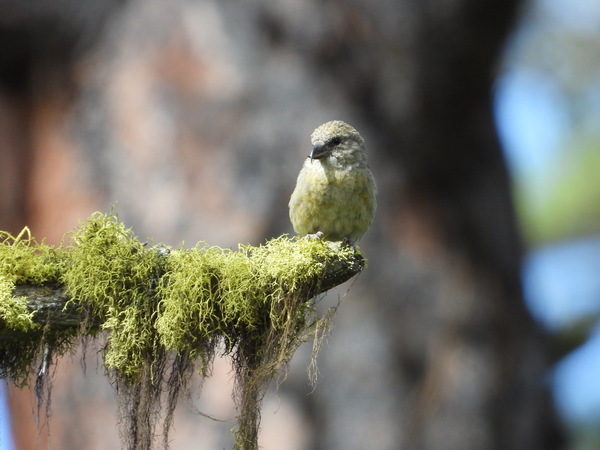
Red Crossbill
Loxia curvirostraMedium-sized finches with unique crossed bills. Females are yellow olive while males are reddish orange.
Mature conifer forests across North America.
Non-migratory, but move in response to food availability.
A loud "kip kip" and a warbling song.
Their unique crossed bill is adapted to pry apart conifer cones and extract the seeds inside.
Red-shouldered Hawk
Buteo lineatusMedium-sized hawk. Adults are brown above with pale underparts and reddish barring on the breast. They have a prominently banded tail.
Moist woodlands, mixed forests, and river valleys across the eastern USA and Pacific coast from southern Oregon to Baja California.
Northernmost populations migrate to the southern USA or Mexico for winter.
A distinctive, repeated "kee-aah" sound, the second note dropping off sharply.
The Red-shouldered Hawk prefers to live in forests, where it can nest in peace and hunt for amphibians and reptiles.
Red-tailed Hawk
Buteo jamaicensisLarge hawks with broad, rounded wings and a short, wide tail. They have rich brown above and pale below, with a streaked belly and on the wing underside reddish-brown tail.
Wide range of habitats, including deserts, grasslands, forests, agricultural fields, roadsides, and urban areas across North America.
Most are non-migratory.
A raspy, scraping, screamed "kreeeeer."
The red-tailed hawk is one of the largest birds in North America and its typical call is often misattributed to that of an eagle (listen closely to the sound effects in movies).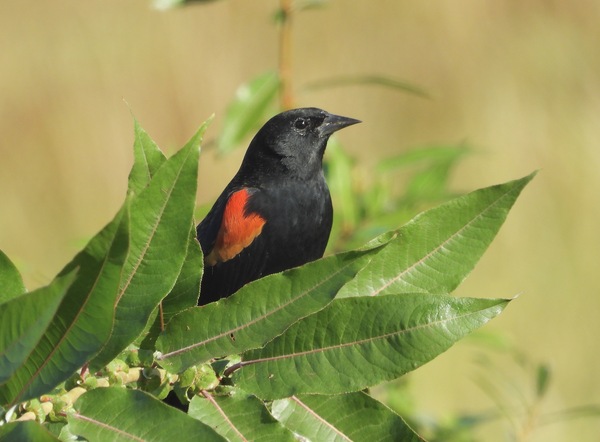
Red-winged Blackbird
Agelaius phoeniceusFemales are brown with darker streaks and hint of orange at the shoulders while males are black with bright red-and-yellow shoulder patches.
Common across North America in marshes, along watercourses, water edges, and wet roadsides.
They are partial migrants; bird populations in the north migrate to the southern U.S. during winter months.
Male's song is a scratchy 'oak-a-lee' which the females respond with a few short notes.
Males are known to fiercely guard their territory during nesting season, bravely chasing off much larger predators.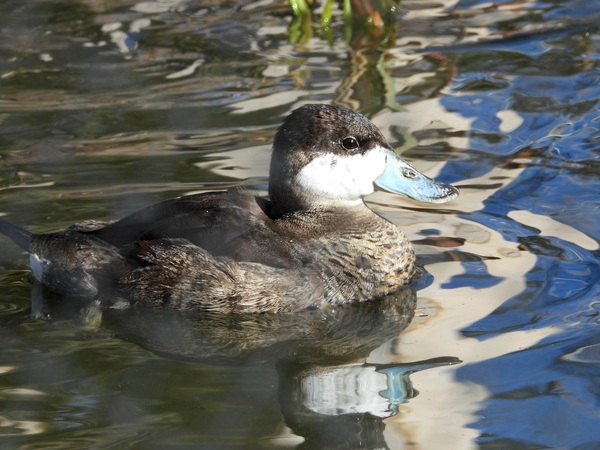
Ruddy Duck
Oxyura jamaicensisSmall, stout duck with distinctive stiff tail often held upright. Body is brown and in the breeding season the male beak will turn bright sky-blue.
Ruddy Ducks inhabit marshes, ponds, and deep wetlands. They prefer freshwater habitats but can also be found in brackish and saltwater wetlands. They are often seen in open water, diving for food.
In North America, Ruddy Ducks breed primarily in the Prairie Pothole region of central Canada and the United States and then migrate to coastal areas and the southern United States, Mexico, and Central America for the winter.
Ruddy Ducks are usually quiet. However, during the breeding season, males make a distinctive chattering and ticking sound, along with a unique 'belching' noise during courtship displays.
The male courtship display is one of the most elaborate among ducks. He begins by puffing out his chest to accentuate his bright white under-feathers. He then raises his tail high and dramatically, leaning forward with his neck low to the water. Next, he starts to beat his bill against his chest rapidly, creating not only a fast-paced tapping sound but also causing a flurry of bubbles in the water, known as a 'bubble storm'. The male then stretches his head upwards, pointing his bill to the sky, while simultaneously kicking down strongly with his legs. This causes him to lunge forward in the water, making a belching sound, sort of a 'pip-pip-pweeet'.
Song Sparrow
Melospiza melodiaMedium-sized sparrow with a long, rounded tail and streaky brown coloration.
Found in open, shrubby, and wet areas across North America.
Most are non-migratory, but northern populations migrate south for winter.
A variable song composed of several phrases, with a rhythm of ‘sweet-sweet-sweet’ notes followed by ‘trills and twitters'.
They have one of the most complex and beautiful songs, with each male choosing a unique combination of notes. In fact, a single male can sing as many as 20 different variations and might use different ones depending on the situation. This makes them a wonderful bird to listen to and a challenge to become familiar with all their melodies.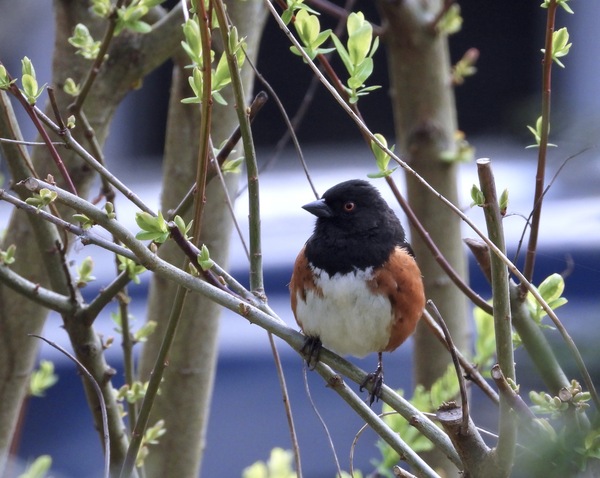
Spotted Towhee
Pipilo maculatusLarge sparrow with red orange flanks, white belly, and a long dark tail with white edges. Females have a darker shaded head, upper body, and tail compared to males.
Dry uplands and shrublands of the western U.S. and southwestern Canada.
Generally non-migratory.
A sweet, mewing call and a fast "drink-your-teeeeeee" song.
Prefer to spend most of their time on the ground, rummaging through leaf litter, often tossing it aside, in search of insects.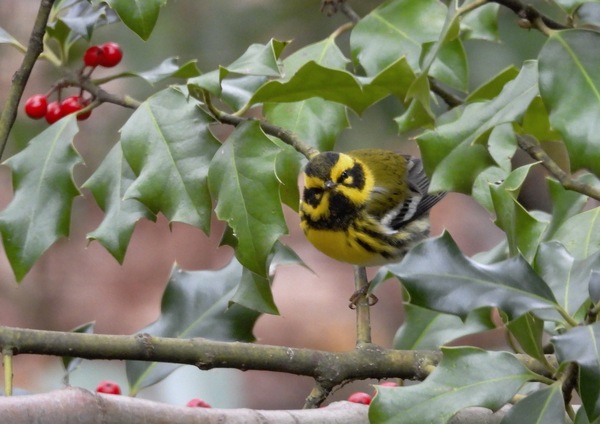
Townsend Warbler
Setophaga townsendiSmall songbird with a yellow face and undersides, olive-green back and wings, and black streaks on its back and flanks.
Commonly found in coniferous forests, especially those with a predominance of firs, and are frequently seen high in the canopy.
They breed in the forests of the Pacific Northwest and western Canada then migrate to Mexico and Central America for the winter. Some populations of this bird species engage in altitudinal migration, moving to lower elevations during the winter months.
They have a high and sharp “tsip” call. Their song begins with several sharp notes and ends with a buzz, sounding like 'seet-seet-seet-szzzz'.
In winter when other food sources are scarce, Townsend Warblers may feed on 'honeydew', a sweet liquid excreted by aphids. This allows them to survive in colder, high-altitude environments compared to other warbler species.
Tree Swallow
Tachycineta bicolorMedium-sized swallow with a blue-green upper body and white underbody. They have a shorter, less forked tail than other swallows.
Fields and wetlands across North America.
They migrate to Central America and the Caribbean for winter.
A soft, liquid twitters and trills.
Tree Swallows are one of the only swallows that also eat plant matter, including bayberries and other fruits.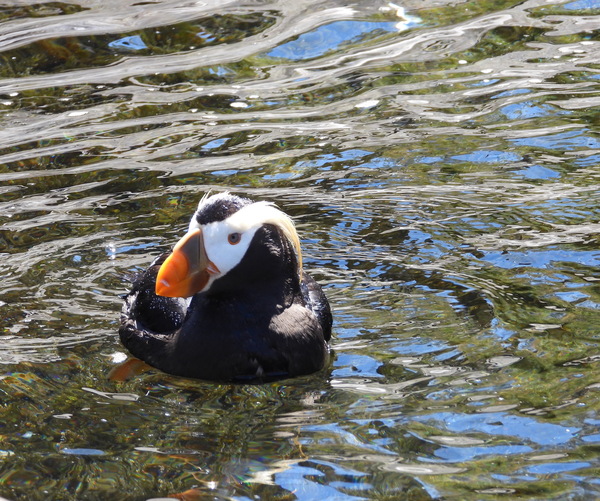
Tufted Puffin
Fratercula cirrhataMedium-sized seabird with a black body and white facemask. Breeding adults have golden feathers on their head and a large red-orange bill.
Found along open ocean and rocky cliffs off the north Pacific coast.
Generally non-migratory, but move out to sea and southwards in winter.
Silent at sea, but will make soft growls and purrs at the nesting site.
These puffins spend most of their lives at sea and only come ashore to breed.
Varied Thrush
Ixoreus naeviusMedium-sized songbird with dark gray-brown upper body, a black breast band, and a bright orange throat and belly.
Dense, wet forests along the Pacific Coast of North America.
Populations in colder regions migrate to the U.S. Pacific Coast or southwestern states.
A long, eerie, drawn out whistle, repeated on different pitches.
Varied Thrushes typically forage on the ground, but unlike most other birds, they do not usually hop or walk. Instead, they use a two-footed, forward-and-back shuffle to move leaves and debris while looking for insects, berries, and other foods.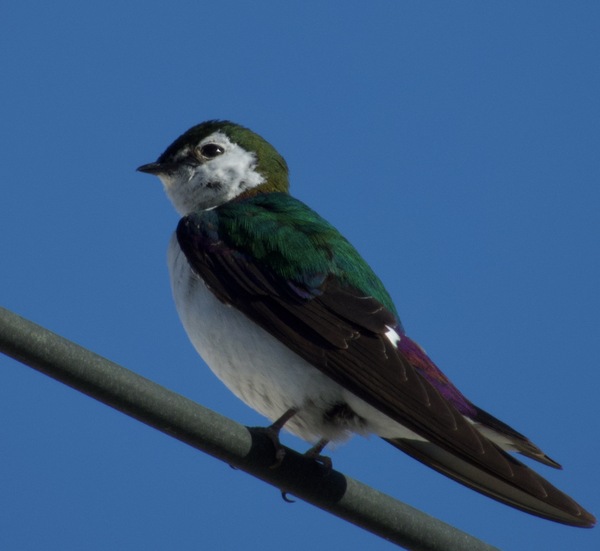
Violet-Green Swallow
Tachycineta thalassinaSmall bird with a metallic green back and purple rump. Their underbody is white, extending onto the sides of the face and around the eye.
Open woodlands, canyons, and mountainous regions of western North America.
They migrate to Central America and Mexico for winter.
Soft, twittering notes.
The Violet-Green Swallow is one of the few species that can outcompete House Sparrows for nest boxes.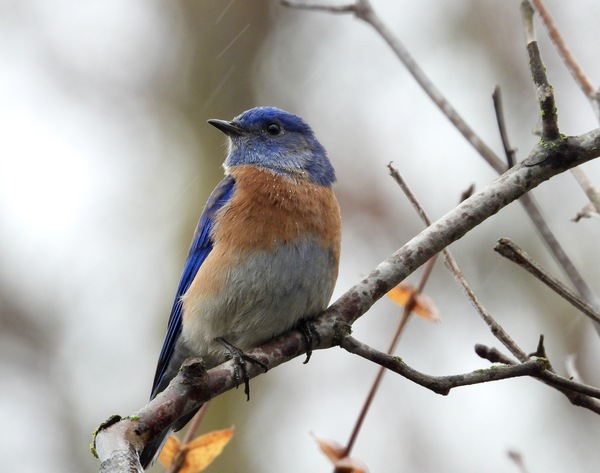
Western Bluebird
Sialia mexicanaSmall thrush with a blue head, back, and wings, and a rust or brick-red breast.
Open woodlands and farmlands across western North America.
Populations in the north and those living at high altitudes migrate south to Mexico for winter.
A soft, low, throaty whistle and a short, dry chatter.
Western Bluebirds nest in cavities or holes in trees, but they are not capable of excavating these themselves. Instead, they rely on natural tree cavities or holes left by other birds such as woodpeckers. They are also known to readily use nest boxes.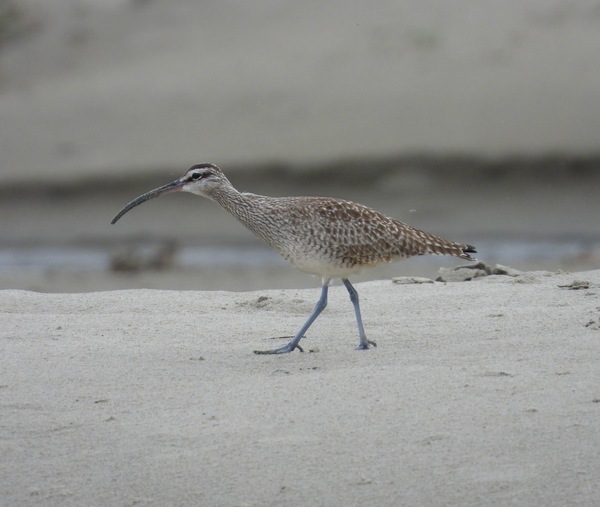
Whimbrel
Numenius phaeopusLarge shorebird with a long, curved bill. They are mostly brown with streaking and a striped head.
Coastal areas, saltmarshes, and tundra across North America.
Some are long-distance migrants, breeding in the Arctic in the Northern hemisphere and wintering in South America.
A high, seven-note whistle often repeated several times.
Adults will aggressively defend their nesting sight, even flying straight at humans before swerving at the last moment.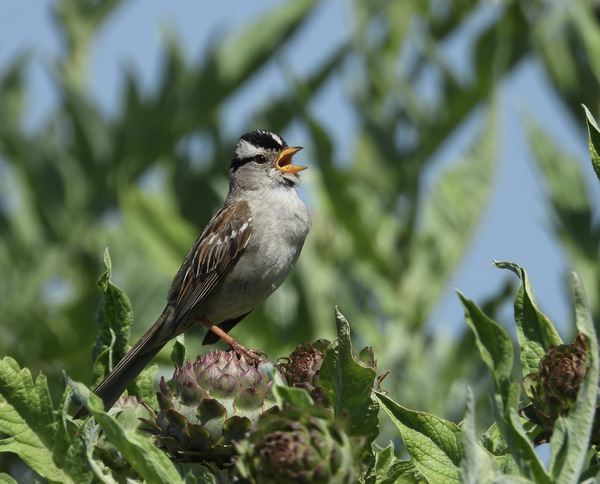
White-crowned Sparrow
Zonotrichia leucophrysMedium-sized sparrow with bold black and white stripes on the head, a gray face, and a long tail.
Open and shrubby habitats such as fields, forest edges, and gardens across North America.
Northern populations migrate to the southern U.S. and Mexico for winter.
A series of clear whistles followed by buzzes or trills.
White-crowned Sparrows have regional "dialects," with birds of the same region singing a similar song that is different from those in other regions.
Wood Duck
Aix sponsaAmong the most colorful and beautiful of ducks. Females are gray-brown with dark blue wing patch, a white eye-ring, and a white throat. Males have a crested iridescent green and purple head, red eyes, and a white throat.
Wooded swamps, shallow lakes, marshes, ponds and creeks in eastern North America, the west coast of the United States, and western Mexico.
In the northern parts of their range, wood ducks are migratory, wintering in the southern United States.
The male utters a soft rising whistle while the female gives a drawn-out, rising squeal, "oo-eek."
The Wood Duck is one of the few North American ducks that can perch and nest in trees. They will readily use nest boxes and are known for the spectacle of their young jumping from the nest tree and heading to water soon after hatching.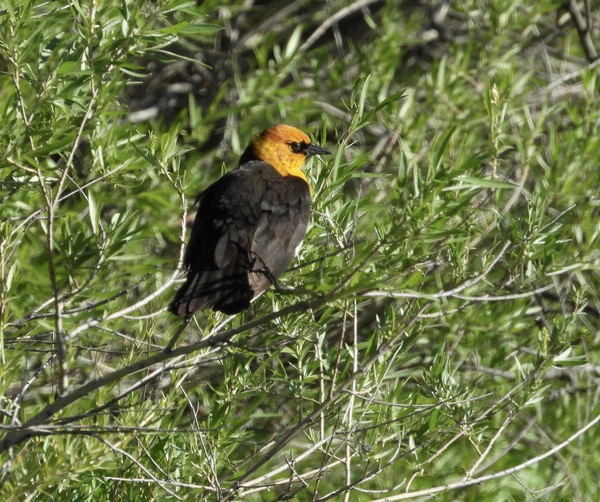
Yellow-headed Blackbird
Xanthocephalus xanthocephalusFemales are brownish-black, with a yellowish-brown head and breast. Males are black with a yellow head and chest, and a white wing patch.
They can be found in the western and midwestern United States where they inhabit freshwater wetlands and marshes.
Northern populations head to the southern U.S. and Mexico for the winter.
Their song is an odd, harsh mix of scratchy notes, commonly described as 'rusty farm machinery' along with chattering sounds.
Nests are always built over water, sometimes proving an extra challenge to the chicks who may sometimes fall in and have to swim to safety.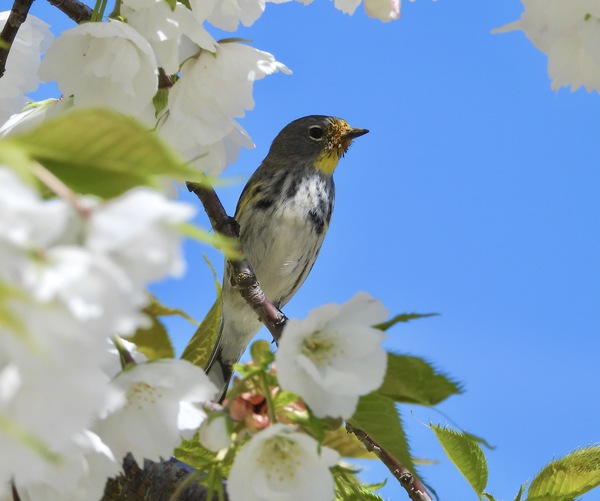
Yellow-Rumped Warbler
Setophaga coronataMedium-sized warbler with a mix of gray, black, yellow and white patches and a bright yellow rump.
They inhabit open coniferous and mixed woodlands, often close to water. During winter, they can be found in a wide range of habitats including shrubs, parks, and gardens.
Yellow-rumped Warblers migrate late in both spring and fall compared to other warbler species. They spend summers in northern parts of North America and winters in the southern United States, Central America and the Caribbean.
They have a varied and musical song, featuring multiple notes that are often described as a trilled “tew-tew-tew” or “check-check-check”.
While most warblers stick to insects and spiders, Yellow-rumped Warblers are capable of digesting waxes in bayberries and wax myrtles, allowing them to survive on these berries during winter.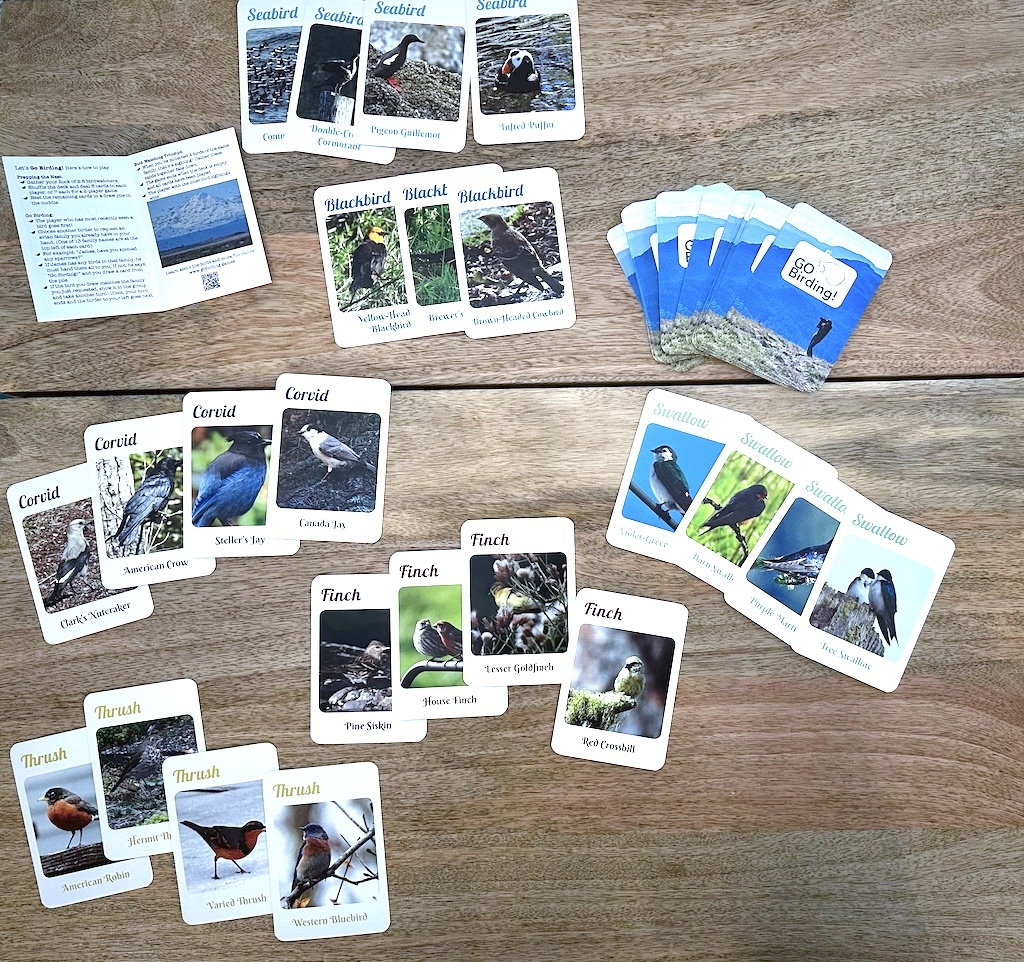
Go Birding Card Game
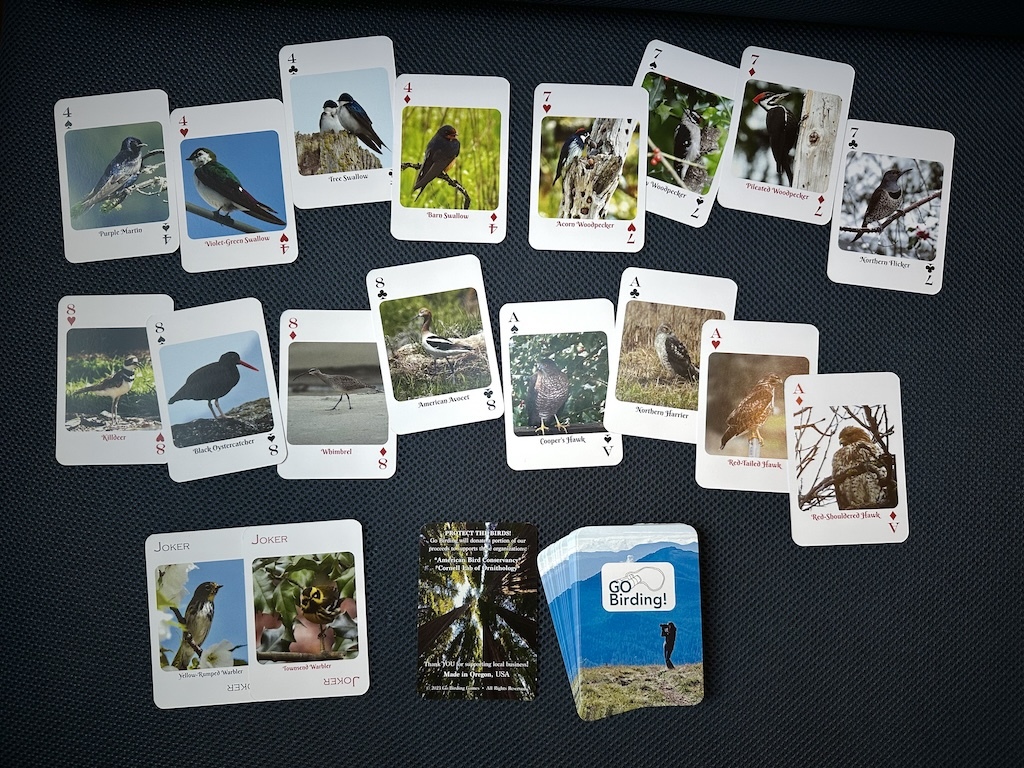
Go Birding Playing Card Deck
